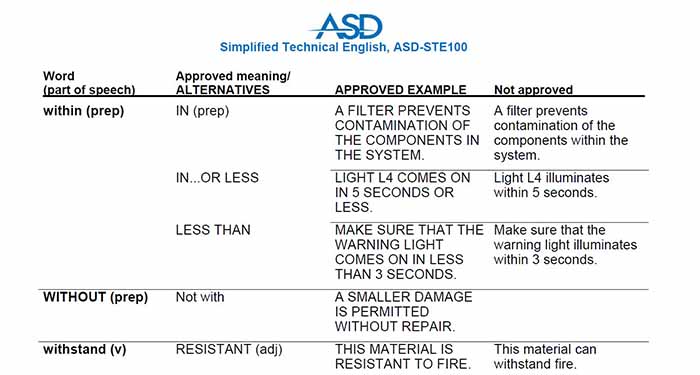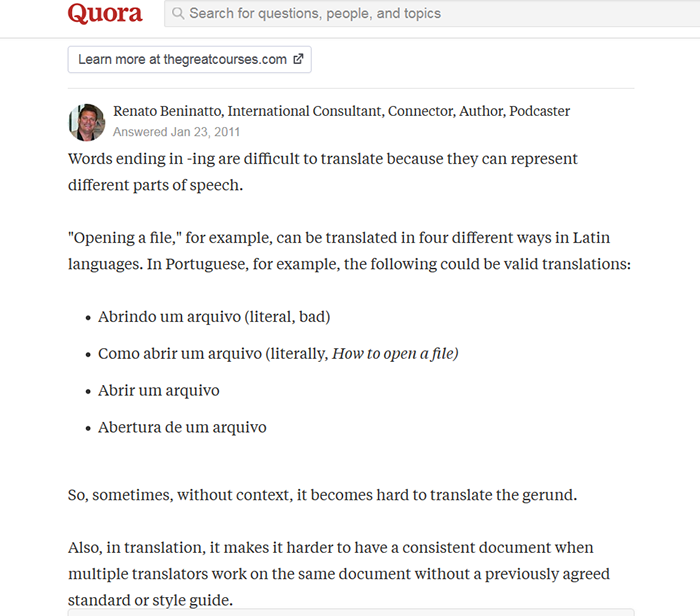 Plain Language and Simplified Technical English: What are they?
Plain Language and Simplified Technical English: What are they?
Plain Language: If you work for the federal government and you write content for the public, you should already be familiar with Plain Language, which is mandated by law. The Plain Language website https://plainlanguage.gov/ describes Plain Language guidelines and how they apply to all documents, from policies to instructions.
The Plain Language movement began as a way to improve the readability of legal language such as what we see in government regulations. However, this movement is growing beyond the federal government, as more organizations look for ways to improve customer experience through well-written content.
Plain Language guidelines include suggestions at the word, paragraph, “section,” and overall organizational levels. According to the introduction to the guidelines, these suggestions will help readers to
- Find what they need
- Understand what they find
- Use what they find to meet their needs
The first rule of plain language is to write for your audience, and currently the PL guidelines include advice about how to write plain content for digital audiences.
Simplified Technical English: If you write for aviation, defense, or aerospace industries, you are most likely familiar with Simplified Technical English (STE). You can download STE guidelines–free at the AeroSpace and Defence Industries Association of Europe (ASD) website: http://www.asd-ste100.org/request.html
According to the “About” page of the ASD website, the STE movement began in Europe in the early ‘80s “to help the users of English-language maintenance documentation understand what they read.” Currently, other industries all over the world now use STE guidelines, which include instructions for how to write technical documents using
- A dictionary of allowed words
- 53 writing rules
The following page from the STE guidelines (ASD-STE100) shows a few of the “w” entries in the STE dictionary of allowed words. The “w” words here are “within,” “without,” and “withstand.”

“Within” guidelines from STE
Note that the word “within” cannot be used as a preposition meaning “in” as in “A filter prevents contamination of the components within the system.” Instead, we should use the word “in.” Why? Because “within” can mean one of three things, either “in” or “in…or less” or “less than.”
- “in” Finish your work within three hours. = Finish your work in three hours.
- “in…or less” Finish your work within three hours = Finish your work in three hours or less
- “less than” Finish your work within three hours = Finish your work in less than three hours.
So, let’s not use “within.” Let’s reduce confusion and use the more precise “in…or less” or “less than.”
However, we can use “without” to mean “not with” as in the permitted STE example, “A smaller damage is permitted without repair.” Note that the passive construction, “…is permitted” is acceptable for STE because it is in a description rather than in a procedure.
Even writers outside the aviation/aerospace industry can benefit from using the STE dictionary and rules to
- Simplify meanings in instructions
- Remove comprehension barriers for ESL readers
- Reduce the possibility of misunderstanding regardless of reader language
- Improve translation
The Overlap between PL and STE Guidelines—and Why it Matters
Most, but not all, of the writing rules of the STE guidelines overlap with Plain Language guidelines. And the STE dictionary helps us to fine-tune our word choice to avoid misunderstanding. Plain Language guidelines cover more territory than STE and are great for those of us who write content other than technical procedures and descriptions.
If you write for anyone other than yourself, PL and STE guidelines can help you to write clearly and succinctly for your audience. Take this brief quiz to see how. But beware, sometimes the guidelines are just guidelines, and your choices can legitimately vary from them.
The Quiz: Some Plain Language and Simplified Technical English (STE) Concepts
Questions
1. Revise this sentence to follow STE guidelines for writing procedures: (page 44 of the ASD-STE100 – Issue 7 (002)1).
Oil and grease are to be removed with a degreasing agent.
2. Revise the following sentence to follow STE guidelines for description-writing.
These values are used by the computer to calculate the energy consumption.
3. Revise the following sentence to follow the Plain Language guidelines for using active and passive voice.
If you do not pay the royalty on your mineral production, your lease will be terminated.
4. Revise this passage to follow STE guidelines for “-ing” words.
Mechanics wearing insufficient protective clothing and opening containers containing hazardous materials in areas where there is a lack of ventilation, using inappropriate tools without observing the manufacturer’s instructions, are in danger of coming into contact with these materials and thus suffering from skin irritation and breathing problems.
5. Revise the following sentence to comply with Plain Language advice to choose the strongest, most direct form of verbs.
This means we must undertake the calculation of the new figures.
Answers
1. Remove the oil and grease with a degreasing agent.
Why?
STE Style Rule 3.6 says:
- Use only the active voice in procedural writing.
- Use the active voice as much as possible in descriptive writing.
2. The computer uses these values to calculate the energy consumption.
Why? STE Style Rule 3.6 says:
- Use only the active voice in procedural writing.
- Use the active voice as much as possible in descriptive writing.
3. No change.
Why?
In the Plain Language guidelines, we learn that, when the law is the actor, or when it doesn’t matter who is doing an action, passive voice may be OK. If we blindly follow the “use active voice” suggestion, we might write something like this sentence below, text that’s probably too humorous for government writing:
The terminator will terminate your lease.
In fact, passive voice can also help with cohesion, but that is a topic for another day.
4. Before you use dangerous materials, obey these precautions:
Read the manufacturer’s instructions.
Make sure that there is sufficient airflow in the work area.
Put on a face mask and protective clothes.
Get the correct tools to open the containers for these materials.
If you do not obey these precautions, injury to your skin and lungs can occur.
Why?
STE Rule 3.5: Use the “-ing” form of a verb only as a modifier in a technical name.
Words that end in –ing, such as “opening”– can be confusing because they can play different roles in a sentence. For example, -ing words can be nouns, adjectives, or part of a verb,
- nouns (gerunds): Opening the theater was thrilling for the new manager.
- adjectives (participles): It was opening
- part of a verb: The theater is opening tomorrow night
According to the STE manual, words that end in –ing can also tempt writers to create long, complex sentences. Instead keep the following guidance in mind:
- Write more concise verbs: Many writing handbooks and websites agree with this advice. For example,org claims that when we overuse –ing in progressive verb forms such as “I am singing” that we must then introduce a lot of helping verbs into our writing. According to Simplewriting.org, these helping verbs or “weak, little words” like “am, are, is, was, have…and had” supposedly add little meaning on their own.
According to Simplewriting.org, “She was really running down the street like a maniac” can be effective for casual spoken English, but that “…was really running…” can be improved in written documents:
She was really running down the street.
Becomes the more concise
She charged down the street.
Paul MacRae (2015, 39-40) agrees with reducing the use of helping verbs in his Business and Professional Writing text. He reminds us that one way to make our sentences more concise is to eliminate helping verbs.
This type of advice is not new. For example, Diyanni and Hoy, in their 2008 version of The Writer’s Handbook (p.194), advise writers to use “strong” verbs—those verbs that are “interesting…specific…and active.”
- Translation issues of “ing” words: Keep in mind that the ambiguous “ing”can create problems for translators, for those readers for whom English is not their first language, and for native speakers of English. Let’s start with an example that contains two “ing” words that can be ambiguous, and therefore both hard to understand and hard to translate.
A large opening manager will find many uses for cleaning fluid.
“Cleaning fluid” can mean “fluid we use when we clean,” such as a solvent.
“Cleaning fluid” can also mean the act of cleaning some liquid item. As in “I was cleaning the fluid.” Perhaps the fluid is contaminated and needs to be cleaned. You can see how a translator might get messed up there.
Here is another example:
A large opening manager visited the theater.
The “large opening manager “could be a manager who is large or a manager of large openings. A graphic might help here, but the simpler solution is to use hyphens to clarify:
- A large-opening manger = a manager who coordinates large events
- A large opening-manager = a manager who is large
Renatto Beninatto agrees with the -ing translation difficulty on Quora.com. His information below will be especially helpful for those who understand Portuguese. https://www.quora.com/Why-are-words-that-end-in-ing-difficult-to-translate

5. This means we must calculate the new figures.
Why?
Plain Language guidelines tell us to avoid “hidden verbs” –aka nominalizations– in its “Choose your words carefully” section: https://www.plainlanguage.gov/guidelines/words/avoid-hidden-verbs/
A nominalization is a verb that someone has turned into a noun. We turn the verb “open” into the noun “opening” by adding an –ing to the end. Here are some other noun-making endings:
-tion
-ment
-ance
The Plain Language site warns us to avoid the long and less clear nominalization, “application” in this example:
Please make an application for a personal loan
Instead, PL best practice is to change that pesky nominalization, “application” back into a verb: “apply.”
Please apply for a personal loan
The Plain Language guidelines help us to be clear and brief. For example, the guidelines remind us that nominalizations make sentences longer because we often have to add another verb to them. For example, “analysis” is a nominalization—a noun formed from the verb “to analyze. Notice that when we choose to write “analysis” we often have to add one of the following verbs:
- Achieve
- Effect
- Give
- Make
- Reach
- Take
- Undertake
- Carry out
These added verbs make our sentences longer than if we used the shorter form: the verb from which the nominalization comes.
| Long | Short |
| Make an analysis
Carry out a review Undertake the calculation |
analyze
review calculate |
Summary
The PL and STE guidelines both suggest we avoid passive voice and nominalizations. However, each set of guidelines helps us as professional writers in different ways. The PL guidelines give us a little more explanation about sentence-level and discourse-level writing choices than the STE guidelines do. On the other hand, the STE guidelines help us to narrow our word choices in more precise ways than the PL guidelines do.
References
Diyanni, Robert and Hoy, Pat. 2008. The Writer’s Handbook. New York: Pearson.
MacRae, Paul. 2015. Business and Professional Writing: A Basic Guide. Ontario, Canada: Broadview Press.
More Resources
TechWhirl Fast 5: Understanding Plain Language and Simpliefied Technical English